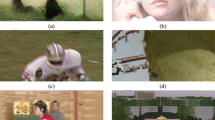Abstract
In this work, we studied the use of combination models to integrate audio and video quality estimates to predict the overall audio-visual quality. More specifically, an overall quality prediction for an audio-visual signal is obtained by combining the outputs of individual audio and video quality metrics with either a linear, a Minkowski, or a power function. A total of 7 different video quality metrics are considered, from which 3 are Full-Reference and 4 are No-Reference. Similarly, a total of 4 audio quality metrics are tested, 2 of which are Full-Reference and 2 are No-Reference. In total, we tested 18 Full-Reference audio-visual combination metrics and 24 No-Reference audio-visual combination metrics. The performance of all combination metrics are tested on two different audio-visual databases. Therefore, besides analysing the performance of a set of individual audio and video quality metrics, we analyzed the performance of the models that combine these audio and video quality metrics. This work gives an important contribution to the area of audio-visual quality assessment, since previous works either tested combination models only on subjective quality scores or used linear models to combine the outputs of a limited number of audio and video quality metrics.







Similar content being viewed by others
References
Bong DBL, Khoo BE (2015) Objective blur assessment based on contraction errors of local contrast maps. Multimed Tools Appl 74.17:7355–7378
Chikkerur S, Sundaram V, Reisslein M, Karam LJ (2011) Objective video quality assessment methods: a classification, review, and performance comparison. IEEE Trans Broadcast 57(2):165–182
Engelke U, Zepernick H-J (2007) Perceptual-based quality metrics for image and video services: a survey. In: 3rd EuroNGI Conference on next generation internet networks, pp 190–197
Farias MCQ, Mitra SK (2005) No-reference video quality metric based on artifact measurements. IEEE Int Conf Image Process ICIP 2005 3(2):III–141–4
Garcia MN, Schleicher R, Raake A (2011) Impairment-factor-based audiovisual quality model for iptv Influence of video resolution, degradation type, and content type. EURASIP J Image Vid Process 1–14
Hands DS (2004) A basic multimedia quality model. IEEE Trans Multimed 6 (6):806–816
Hines A, Skoglund J, Kokaram A, Harte N (2012) Visqol: the virtual speech quality objective listener. In: International workshop on acoustic signal enhancement. Proceedings of IWAENC 2012. VDE, pp 1–4
Hines A, Skoglund J, Kokaram A, Harte N (2013) Robustness of speech quality metrics to background noise and network degradations: comparing visqol, pesq and polqa. In: 2013 IEEE International conference on acoustics, speech and signal processing (ICASSP). IEEE, pp 3697–3701
Hines A, Gillen E, Harte N (2015) Measuring and monitoring speech quality for voice over IP with POLQA, ViSQOL and P. 563. In: Interspeech conference. Dresden, pp 6–10
ITU Recommendation BT.500-8 (1998) Methodology for subjective assessment of the quality of television pictures
Lin W, Kuo C-CJ (2011) Perceptual visual quality metrics: a survey. J Vis Commun Image Represent 22(4):297–312
Malfait L, Berger J, Kastner M (2006) P.563 The itu-t standard for single-ended speech quality assessment. IEEE Trans Audio Speech Lang Process 14(6):1924–1934
Martinez HB, Farias MCQ (2014) A no-reference audio-visual video quality metric. In 2014 Proceedings of the 22nd European on signal processing conference (EUSIPCO), pp 2125–2129
Martinez HB, Farias MCQ (2014) Full-reference audio-visual video quality metric. J Electron Imag 23(6):061108–061108
Mittal A, Moorthy AK, Bovik AC (2011) Blind/referenceless image spatial quality evaluator. In: Conference record of the forty fifth asilomar conference on signals, systems and computers (ASILOMAR). IEEE, pp 723–727
Mittal A, Soundararajan R, Bovik AC (2013) Making a “completely blind” image quality analyzer. IEEE Signal Process Lett 20(3):209–212
Moorthy AK, Bovik AC (2010) A two-step framework for constructing blind image quality indices. IEEE Signal Process Lett 17(5):513–516
Moorthy AK, Bovik A C (2011) Visual quality assessment algorithms: what does the future hold? Multimed Tools Appl 51(2):675–696
Pinson MH, Wolf S (2004) A new standardized method for objectively measuring video quality. IEEE Trans Broadcast 50(3):312–322
Pinson MH, Ingram W, Webster A (2011) Audiovisual quality components. Signal Process Mag IEEE 28(6):60–67
Pinson MH, Schmidmer C, Janowski L, Pépion R, Huynh-Thu Q, Corriveau P, Younkin A, Le Callet P, Barkowsky M, Ingram W (2013) Subjective objective evaluation of an audiovisual subjective dataset for research and development. In: Fifth International workshop on quality of multimedia experience (QoMEX). IEEE, pp 30–31
Soh K, Iah S (2001) Subjectively assessing method for audiovisual quality using equivalent signal-to-noise ratio conversion. Trans Inst Electron Inform Commun Eng A 11:1305–1313
Thiede T, Treurniet WC, Bitto R, Schmidmer C, Sporer T, Beerends JG, Colomes C (2000) Peaq-the itu standard for objective measurement of perceived audio quality. J Audio Eng Soc 48(1/2):3–29
Wang Z, Sheikh HR, Bovik A (2002) No-reference perceptual quality assessment of jpeg compressed images. IEEE Int Conf Proc 1:I–477–I–480
Wang Z, Sheikh HR, Bovik AC (2002) No-reference perceptual quality assessment of jpeg compressed images. In: 2002 International conference on image processing. 2002 Proceedings, vol 1, pp I–477–I–480
Wang Z, Lu L, Bovik A (2004) Video quality assessment based on structural distortion measurement. Signal Process Image Comm 19:121–132
Winkler S, Faller C (2006) Perceived audiovisual quality of low-bitrate multimedia content. IEEE Trans Multimed 8(5):973–980
Yamagishi K, Gao S (2013) Light-weight audiovisual quality assessment of mobile video Itu-t rec. p.1201.1. In: IEEE 15th International workshop on multimedia signal processing (MMSP), pp 464–469
Acknowledgments
This work was supported in part by Conselho Nacional de Desenvolvimento Científico e Tecnológico (CNPq) Brazil, in part by Coordenação de Aperfeiçoamento de Pessoal de Nível Superior (CAPES) - Brazil, and in part by the University of Brasília.
Author information
Authors and Affiliations
Corresponding author
Rights and permissions
About this article
Cite this article
Martinez, H.A.B., Farias, M.C.Q. Combining audio and video metrics to assess audio-visual quality. Multimed Tools Appl 77, 23993–24012 (2018). https://doi.org/10.1007/s11042-018-5656-7
Received:
Revised:
Accepted:
Published:
Issue Date:
DOI: https://doi.org/10.1007/s11042-018-5656-7




